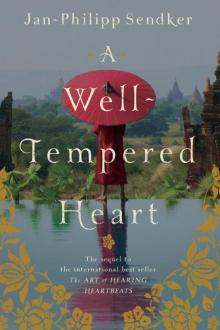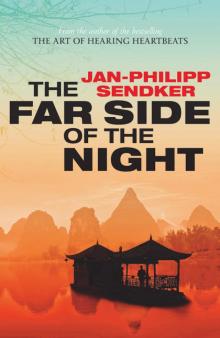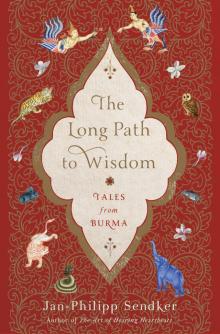- Home
- Jan-Philipp Sendker
The Long Path to Wisdom Page 13
The Long Path to Wisdom Read online
Page 13
A couple of the men stepped menacingly toward the girl, who started to cry. The men wavered briefly, then turned to the brother, who laughed nervously, not really understanding what was afoot. Without hesitating the men snatched him up. Wailing loudly in fright, the girl ran and hid in the brush.
Back in the village the grandmother waited at the door for the return of her dear little ones. At last she saw a long line of people approaching. The villagers were coming back! The men were overloaded with fish. It looked as if they had had a bumper catch. The old woman kept a sharp eye out for her grandchildren, but they were not in the throng.
Down at the river the sister ventured warily out of hiding only after weeping for hours. She went to the water’s edge, where she noticed a little shrimp floating. Had her grandmother not said that a dead person’s spirit might find its new home in a nearby animal? She scooped the little creature gingerly into a bucket and ran home in tears.
Meanwhile, the grandmother was still waiting at the door of the hut for her grandchildren. She was dreadfully worried about them, for the sun was already low in the sky. Finally she saw a little girl in the distance running toward her. The girl fell into her grandmother’s arms and wept disconsolately. Between sobs she managed to tell her grandmother what had happened.
A shiver ran down the old woman’s spine when she heard the appalling tale. By the time the girl was finished the old woman had lost all feeling. Her hands began to tremble with rage, and she stood up. From the innermost corner of the little hut she fetched a staff that had been in the family for generations. One day it would have belonged to her grandson. The two set out together, climbing higher and higher into the mountains. It was strenuous work, but wrath drove the old woman on and on.
Eventually they found themselves atop the highest peak in the region. The grandmother took the girl in her arms and kissed her. Then she straightened up and uttered a curse in a furious voice. She cursed the people who had taken her grandson from her. She cursed the people who had been utterly without compassion or humanity. She cursed the sick, incurable world in which such a thing could ever have happened. Then, with all her might, she thrust the staff into the ground.
From their vantage point up on the mountain the woman and the girl could see clearly how the rivers overran their banks. How the water rose and washed over that village and all the other villages. How it engulfed field and forest and eventually reached even the mountaintop and swept it away. In the end there was nothing left but the smooth surface of the water, while the dregs of the old world now rested on the new ocean floor.
In a small village near the city of Tagaung there lived an elderly couple with one child, a son named Maung Pauk Kyaing. The couple naturally wanted to ensure that their child received the best possible education, so as soon as they deemed him old enough, they sent him to study under a renowned teacher in Taxila. They were convinced he would obtain an education superior to any other. Unfortunately, this was not to be. As it turned out, Pauk Kyaing had no aptitude for learning. He was never able to remember his lessons, and after many years of fruitless labor the unhappy student prepared to return to his hometown and parents.
Pauk Kyaing may have been a poor student, but he possessed other remarkable traits, above all a robust physical stature coupled with a keen sense of perception. His teacher recognized this and did not want to send him home without impressing on him at least a few insights. He also wanted show that the boy’s time under his tutelage had not been a complete waste.
Just before the boy began his long journey home, the teacher came to him and told him he wanted to give him one last lecture for the road. This lesson would serve him for the rest of his life. The student, who had now matured into a young man, was thankful for the guidance and listened attentively as the teacher shared three pieces of advice: “Only one who travels will reach his destination. Only one who asks will receive an answer. Only one who sleeps less will get more out of life.”
Armed with this new wisdom, which he burned into his memory, Pauk Kyaing confidently set off for home. As his teacher had predicted, this journey was without a doubt the only way to get from one place to the next. Perhaps the fruitless years of apprenticeship would ultimately prove to be worthwhile on account of his teacher’s advice.
After many weeks of travel Pauk Kyaing reached the region of Tagaung. The capital itself is in the Mandalay district, on the east bank of the Irrawaddy River. As he neared the metropolis he came upon a number of ministers from the king’s palace, who told him that the kingdom of Tagaung was currently without a ruler. Because his teacher’s parting words were still fresh in his memory and because he wanted to know more, Pauk Kyaing did not hesitate to ask about how this state of affairs came to pass.
The ministers told him that the king had been murdered some time ago and that anyone since then who had ascended to the empty throne to rule beside the widowed queen had been found dead the next morning. Understandably, the violent demise of so many had made the job considerably less appealing than it would otherwise have been. The ministers had run out of candidates and did not know where else to turn. Wondering what could have caused the death of so many hopeful young men, Pauk Kyaing volunteered to be the next candidate.
The ministers were overjoyed and also relieved. Although they were convinced that Pauk Kyaing would meet the same fate as his predecessors, the arrival of a new candidate promised to reduce the pressure on them, at least during the preparations for the new king’s inauguration. With a fanfare that could be heard far and wide, Pauk Kyaing was led to the castle, where he was met with a grand reception, as befitted his status as the future king. Numerous vats were filled with fragrant waters and then blessed. The water served to purify the body, mind, and soul in order to prepare the young man for the position of responsibility.
After the ritual cleansing, the attendants clothed Pauk Kyaing in costly robes worthy of a ruler, and they placed the king’s throne next to the oft-widowed queen’s. During the coronation festivities the ministers as well as the other palace spectators were highly impressed by the inner strength that emanated from this chance aspirant, even though they had clearly warned him just that morning about his possible fate. When the courtiers and ministers lined up to swear their oaths of fealty, there were many among them who were sorry that such a courageous and brave young man would no longer be among the living the next morning.
These speculators, however, did not know Maung Pauk Kyaing or the valuable wisdom he had acquired from his widely acclaimed teacher. That evening, as the monarchs prepared to retire, the newly minted king recalled his teacher’s third lesson. On that advice, he fought with all his might to ward off sleep, even though it had been a long, arduous day and he was completely exhausted. He lay awake pondering all of the possible causes for the kings’ deaths. Earlier in the day he had asked questions, and as his teacher had said, he had received answers. He had learned that the bodies of the kings had been colored black, from which it was surmised that they had been poisoned. As Pauk Kyaing considered the situation, however, another scenario presented itself. What if it was not poison at all but the fiery breath and the powerful talons of a one- or many-headed naga dragon that had killed his predecessors?
The king devised a plan. He called in his servants and ordered them to fetch him a large amount of banana leaf stalks and a finely honed sword. As soon as the stalks had been collected the king tied them into a human-sized bundle and covered it with his clothes and a blanket so as to create the appearance that he lay sleeping in his bed. Despite his overwhelming drowsiness, Pauk Kyaing followed his mentor’s advice and resisted the urge to sleep. Instead, he withdrew to a corner of the bedroom and hid behind heavy curtains while waiting to see what would happen. The night passed ever so slowly. The waiting seemed endless, and the quietness of the castle only heightened the oppressive eeriness of his situation. Just when he could no longer fight off sleep and was on the verge of abandoning his hiding place,
he heard a soft scraping. It sounded as if something heavy were being dragged back and forth along the tiled palace floor. The noise grew louder—someone or something was clearly coming nearer.
Pauk Kyaing peered out from behind the curtain just in time to see a naga of frightening proportions gliding into the room. He cast a broad shadow by the light of his own fiery-red eyes, and in their glow Pauk Kyaing could make out the endless sparkling rows of scales along the mighty tail he whipped from side to side at every step. The moment he entered the bedchamber, the dragon sprang onto the man-sized bundle, assuming it was the king. His deadly claws sank into the supple foliage of the banana trees, where they caught fast. Desperately the naga struggled to free himself. Pauk Kyaing, who had been watching the events, rushed toward the dragon sword in hand and struck him with powerful blows. The would-be assassin writhed in pain and rage, but Pauk Kyaing finished him off, hacking his body to pieces. Only when the dragon lay still before him did he allow himself to fall asleep.
The next morning the king’s servants entered the bedchamber with great trepidation. They expected to find the mortal remains of yet another tragic victim. How surprised and overjoyed they were to learn that Pauk Kyaing had not only survived the night, but also managed to defeat the monster responsible for so many violent deaths. For his ingenuity, daring, and heroic bravery, Pauk Kyaing was rightly celebrated as a true and distinguished ruler.
The pieces of the naga‘s corpse were collected and brought before the queen. When she saw these proofs of the monster’s death she was beside herself. In the meantime it had become obvious that the naga had been the queen’s secret lover. Together the two had conspired to dispense with anyone who came between them. Knowing well that such treachery was punishable by death, the queen made a crafty proposal in order to escape conviction. Hoping to regain the king’s trust, she feigned gratitude to him for defeating the naga, who, as she now claimed, had forced himself upon her every night. She asked the king to postpone her execution and to solve a riddle of her own contrivance within a limited amount of time. Should he succeed, she would face her death; otherwise he must pardon her and die in her place.
Being a just king, and feeling disinclined to execute a woman of royal blood, Pauk Kyaing generously agreed. Perhaps he let himself be put to the test because he felt sure he would prevail. He had, after all, solved the mystery of the king’s murder, which no one else had been able to do. But when the queen, known for her craftiness, recited the riddle, Pauk Kyaing regretted his generosity. It went like this: “One thousand for the skinning, one hundred for the sewing, skin for a pillow, and bones for hairpins.”
Pauk Kyaing thought hard, but he was unable to decipher the meaning of the words, however much he tried.
As the days passed and there was still no answer in sight, the king’s subjects grew anxious. They did not wish to lose another ruler, especially one who had proven himself to be so noble and fearless. When only one day remained to solve the queen’s riddle the whole land was close to despair; the impending deadline and the consequences of missing it were discussed at every gathering in the kingdom, even among the animals.
Meanwhile Pauk Kyaing’s parents had been missing their only son, but the news of the new king spread quickly, and when they heard of his heroics and his coronation, they hurried see to him.
Along the way, tired from the arduous journey, the old couple decided to rest and to eat their midday meal under a shady tree. The crumbs from their provisions attracted some crows. These birds, having always been inclined to chattiness, seemed particularly talkative that day. Since the couple came from a small village, where man and nature are closely connected, they were familiar with the behavior of the animals and could even communicate with some of them. When the crows came within earshot, the parents were amazed to hear that they were talking about their son, the newly crowned king. In this way they learned of the disaster that threatened to ruin him.
Deeply worried, they hurriedly packed the remains of their lunch. But just before they departed, they overheard one crow asking another if she knew the answer to the riddle. The couple waited with bated breath, and indeed, the crow claimed to know the solution. After the dragon’s death, this crow had sneaked into the queen’s bedchambers hoping to feast on his remains. With her own eyes she had seen what the queen had done with the dismembered dragon. She had paid the tanner one thousand silver coins to skin the dragon; she then gave the royal seamstress one hundred silver coins to sew the skin into a pillowcase on which the queen could rest her head. The dragon’s bones were saved as well and carved into hairpins to adorn the queen’s hair.
The old couple did not quite understand the meaning of what they had heard, but they knew that their son was in grave danger, so they hastened to the palace in Tagaung. Pauk Kyaing was overjoyed to see his parents, but their happy reunion soon took a sad turn as he described his miserable plight. When his parents recounted the birds’ conversation, however, Pauk Kyaing realized that the crow’s explanation must be the solution to the riddle.
For the first time in many nights he fell back into a deep and restful sleep. When the queen came before him the next morning, she was dismayed and chagrined to find that Pauk Kyaing could answer her riddle. To dispel all doubt, the king presented both the pillowcase made from the naga‘s skin and the hairpins made from his bones as proof. Realizing that her plan for revenge had failed, the queen prepared herself for her execution. Having recently wrestled with the disturbing prospect of his own death, the king, whose heart was truly magnanimous, pardoned the queen a second time.
The advice Pauk Kyaing had received as a farewell gift from his teacher had shown him the way and enabled him to become king. During his long and blessed rule, Pauk Kyaing always followed this advice. The kingdom grew and prospered under his wise and capable rule, and he was known by all as a clever and wise monarch. In the end the king and the queen bore two blind boys who founded yet another legendary kingdom in Burma.
Long ago there were two brothers of royal birth named Thamala and Vimala. Thamala, the older of the two, eventually became king while his younger brother was the crown prince.
King Thamala reigned over the region’s fertile plains, where many of his subjects worked the fields or kept livestock. Among the many homesteads there was one particular little piece of land where a husband and wife raised vegetables. The pumpkin was their finest crop: a luminous golden squash that contrasted sharply with the profuse green leaves that hung from the plants’ thick and elegantly intertwining vines. The couple also had a daughter who was not only good-natured but also so extraordinarily beautiful that no one who passed could fail to notice her, whether she was tending the fields with her parents or helping to bring in the bountiful harvest. Her flawless skin shimmered almost ethereally, as if reflecting the golden luster of the pumpkins.
As harvest time neared, King Thamala determined that it was time for him not only to choose a bride but also to send out his troops to get a better understanding of his kingdom. The soldiers received explicit instructions to keep an eye out for young women whose notable virtues might qualify them to be his future spouse. As the men inspected the far-flung regions of the realm in fulfillment of their duties, they eventually came to the little farm with the abundant vegetable harvests. When the farmer’s daughter caught sight of the approaching soldiers, she was afraid and ran into the pumpkin patch to hide. But her radiant beauty could not be concealed, and the men soon discovered her amid the thick foliage. Although they had already been combing the rural districts for a considerable time, they had never come across a girl who could compare in appearance with the farmer’s daughter. Her exquisite beauty was plain to see, despite her simple clothing and the mud splatters she had picked up in her mad dash through the pumpkin patch. Convinced that the king would be delighted with this enchanting candidate, the soldiers pulled her out of the tangled leaves and vegetables where she had sought refuge. They then returned in all haste to the
palace in order to present to the king the beautiful young woman they had rooted out of her peculiar hiding place.
The king was indeed deeply impressed by the young woman his soldiers had spied among the pumpkin vines, and he made her his wife. People endearingly called her the Pumpkin Queen, an allusion both to her background and to the circumstances of her discovery. Not long thereafter a son was born to the royal couple. People rejoiced throughout the kingdom, and yet there was one person who found in this no cause to celebrate: the crown prince. Desiring to be king himself, Vimala could not tolerate the birth of a direct heir whose claim to the throne would be stronger than his own.
Being of no mind to be displaced, Vimala instigated a revolt against his older brother. Within a short time the king was slain in battle, and the crown prince ascended to the throne. To ensure that no one else could lay claim to power, he banished his sister-in-law and her young son without any advance warning to a distant location in the border region between the Karen and the Mon.
So abrupt was the queen’s departure that her court was unable to make appropriate preparations, and the laborious journey ended tragically for mother and child. The unfortunate queen eventually grew so exhausted that her milk failed. Hoping desperately that someone would find him and care for him, she wrapped her son snugly in blankets and laid him by the side of the road.
Aside from various animals, many of them dangerous, there were few inhabitants of this border region. Among those few was a widow who tended a herd of buffalo and who was known by the name Mi Nankarai. One morning as she was wandering through the hills, she discovered, to her amazement, an infant wailing bitterly in the tall grass. Because this was a favored grazing ground for the buffalo, and because the child lay right in the path of the approaching beasts, she put a quick halt to the animals’ progress, lest the child be trodden beneath their hooves. The cloths in which the child was wrapped seemed to the buffalo herder inconceivably precious. Mi Nankarai surmised that the boy had been abandoned by some noble house, perhaps even a house of royal lineage. Because she had found him so near the border that separated the Karen and the Mon, she named him Kwan Eet Thar, which in the language of the Mon meant something like “Prince of the Border.”

 The Language of Solitude
The Language of Solitude A Well-Tempered Heart
A Well-Tempered Heart The Art of Hearing Heartbeats
The Art of Hearing Heartbeats The Far Side of the Night
The Far Side of the Night Whispering Shadows
Whispering Shadows Dragon Games
Dragon Games The Long Path to Wisdom
The Long Path to Wisdom